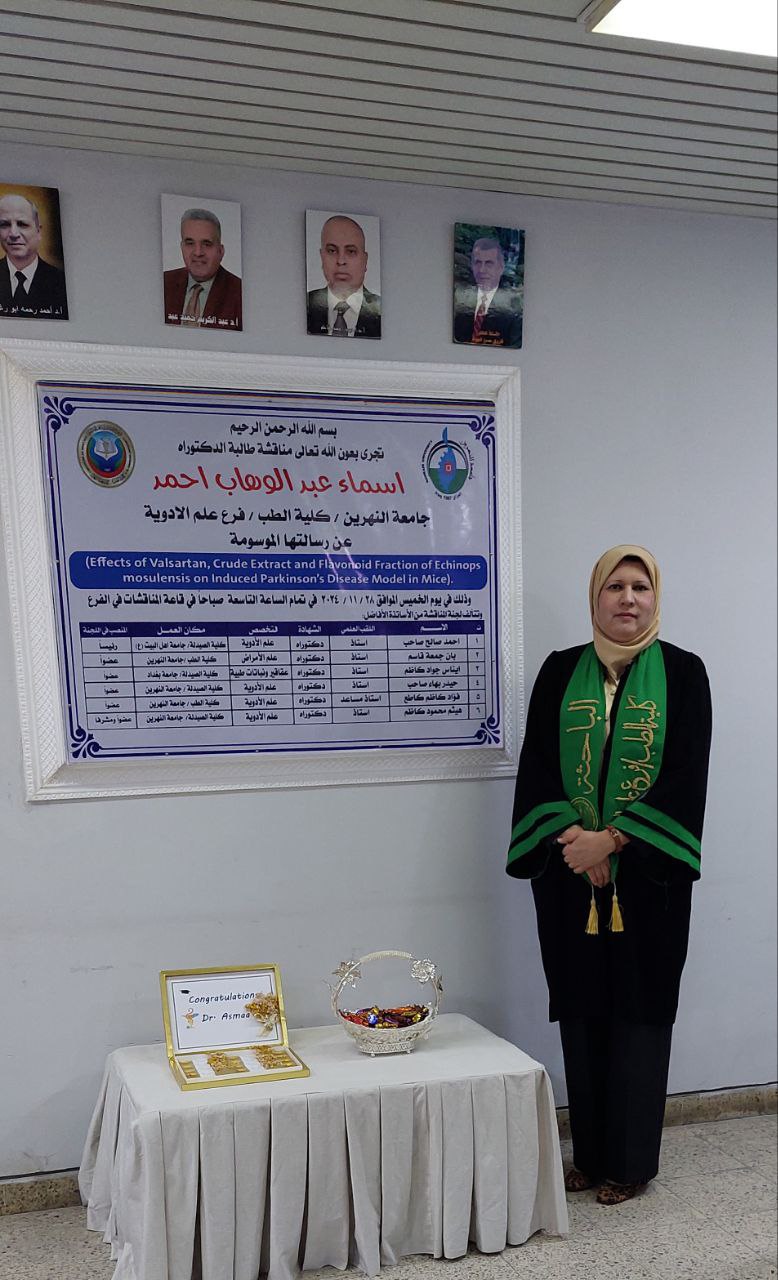On Thursday, November 28, 2024, the PhD candidate Asmaa Abdulwahab Ahmed from the Pharmacology Department at Al-Nahrain College of Medicine successfully defended her dissertation entitled: Effect of Valsartan, Crude Extract, and Flavonoid Fraction of Echinops mosulensis on Induced Parkinson’s Disease Model in Mice Background:Parkinson's disease is the second most common chronic and progressive neurodegenerative disorder after Alzheimer's disease. Classical anti-Parkinson’s drugs primarily aim to compensate for the diminishing dopamine levels; however, the use of these drugs is still associated with a wide range of clinical issues, which has created an urgent need to incorporate various drugs targeting other pathological events accompanying neurodegeneration, such as oxidative stress, inflammation, and apoptosis. Therefore, drugs proven to have antioxidant, anti-inflammatory, or anti-apoptotic effects are believed to be potentially effective against Parkinson's disease and deserve further study. Valsartan directly inhibits the effects of angiotensin II on the AT1 receptor and is widely used today due to its neuroprotective properties. Meanwhile, Echinops mosulensis, belonging to the genus Echinops in the Asteraceae family, contains a wide range of chemicals, including alkaloids, flavonoids, fats, terpenoids, steroids, and polyacetylenes. Among the various secondary metabolites, phenolic compounds have multiple beneficial effects on humans, including the treatment of neurodegenerative disorders. Both compounds possess neuroprotective properties, and the current study investigates their effects against Parkinson's disease. Objectives:To investigate the effectiveness of Valsartan, crude extract, and flavonoid fraction of Echinops mosulensis in combating Parkinson's disease in an MPTP-induced Parkinson's disease model in male albino mice. Results:The current study revealed that, compared to the normal control group, the Parkinson's disease model showed a significant increase in malondialdehyde, interleukin-1β, interleukin-6, caspase-3, and cytochrome-c, while dopamine and tyrosine hydroxylase levels were significantly reduced, along with a notable increase in alpha-synuclein levels. Additionally, significant changes were observed in neurobehavioral tests, characterized by a substantial decrease in the distance traveled in the open field test and a significant increase in rigidity and pole tests. Regarding histopathological examination of the brain, there were severe signs of vacuolated spaces, neuronal loss, pyknotic nuclei, and the presence of Lewy bodies. The groups treated with Valsartan, crude extract, and flavonoid fraction of Echinops mosulensis alongside Parkinson’s induction showed a marked improvement in the measured parameters and histopathological features compared to the induced models, with the crude extract of Echinops mosulensis yielding better results compared to both Valsartan and the flavonoid fraction of Echinops mosulensis. Examination Committee:Prof. Dr. Ahmed Saleh Sahib (Chair) Prof. Dr. Ban Jumaa Qasim (Member) Prof. Dr. Enas Jawad Kadhim (Member) Prof. Dr. Haider Baha Sahib (Member) Asst. Prof. Dr. Fouad Kadhim Kadhim (Member) Prof. Dr. Haitham Mahmoud Kadhim (Member and Supervisor)
The dissertation was successfully accepted with distinction. 


|